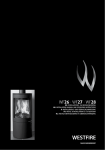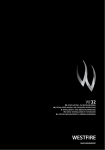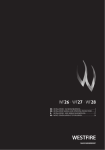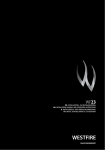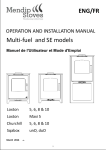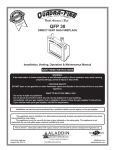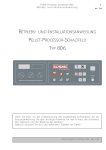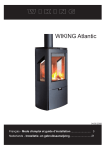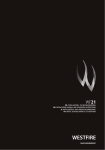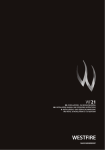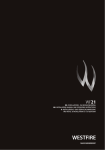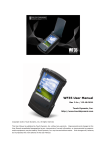Download WF35_SE_ 2014_v1
Transcript
WESTFIRE · WF35 WF35 uk: INSTALLATION MANUAL AND OPERATING INSTRUCTIONS d: INSTALLATIONS- UND GEBRAUCHSANWEISUNG fr : NOTICE D’INSTALLATION ET D’UTILISATION nL: INSTALLATIEHANDLEIDING EN GEBRUIKSAANWIJZING dansk ingeniør kunst 1 WESTFIRE · WF35 WF35 uk: d: fr : nL: INSTALLATION MANUAL AND OPERATING INSTRUCTIONS.....3 INSTALLATIONS- UND GEBRAUCHSANWEISUNG..................18 NOTICE D’INSTALLATION ET D’UTILISATION..........................21 INSTALLATIEHANDLEIDING EN GEBRUIKSAANWIJZING ........24 WESTFIRE 2013 | WF35 1.0 WESTFIRE · WF35 UK: Installation manual and operating instructions WF35/ uniq 35, uniq 35 inset This manual refers to the stove types listed above, which have been tested in accordance with EN13240. Please read this manual carefully in order to ensure that you get maximum enjoyment from your new stove and to prevent any problems. Please note that “ all local regulations, including those referring to national and European Standards, need to be complied with when installing this appliance”. For further information on installing and using fireplaces and multi-fuel stoves, please see the relevant building regulations that apply to the country in which WESTFIRE UNIQ 35 has been approved. These instructions cover the basic principles to ensure the satisfactory installation of the WESTFIRE UNIQ 35 stove, although detail may need slight modification to suit particular local site conditions. In all cases the installation must comply with current Building Regulations, Local Authority Byelaws and other specifications or regulations as they affect the installation of the stove. It should be noted that the Building Regulations requirements may be met by adopting the relevant recommendations given in British Standards BS EB 8303, BS EN 15287 design, installation and commissioning of chimneys as an alternative means to achieve an equivalent level of performance to that obtained following the guidance given in Approved Document J. Health and safety Precautions Special care must be taken when installing the stove such that the requirements of the Health and Safety at Work Act are met. Handling Adequate facilities must be available for loading, unloading and site handling. fire Cement Some types of fire cement are caustic and should not be allowed to come into contact with the skin. In case of contact wash immediately with plenty of water. Asbestos This stove contains no asbestos. If there is a possibility of disturbing any asbestos in the course of installation then please seek specialist guidance and use appropriate protective equipment. CO alarms Building regulations require that whenever a new or replacement fixed solid fuel or wood/biomass appliance is installed in a dwelling a carbon monoxide alarm must be fitted in the same room as the appliance. Further guidance on the installation of the carbon monoxide alarm is available in BS EN 50292:2002 and from the alarm manufacturer’s instructions. Provision of an alarm must not be considered a substitute for either installing the appliance correctly or ensuring regular servicing and maintenance of the appliance and chimney system. Metal Parts When installing or servicing this stove care should be taken to avoid the possibility of personal injury. Stove paint aerosols Paint aerosols are flammable and therefore dangerous to use around a lit stove. Be sure to allow aerosol spray paints to dry and ventilate the room well before lighting the stove. The use of any aerosol around lit stove is dangerous and care must be take in handling aerosols. 3 uk uk WESTFIRE · WF35 West fire Uniq 35 Model choice Closed combustion uniq 35 standard uniq 35 PedestaL uniq 35 inset 50mm base 400mm pedestal 3 sided frame 4 sided frame Yes Yes Yes Yes Stove Performance & testing Westfire Uniq 35 models have been approved in accordance with EN 13240. stove model efficiency Weight Wood/coal nominal heat output CO@ 13% 02 Wood smokeless fuels Wood/coal uniq 35 standard 80.3%/76% 80kg 4.3 KW 3.7KW .12/.17 uniq 35 pedestal 80.3%/76% 110kg 4.3KW 3.7KW .12/.17 Preparatory Work and safety Checks – important Warning important Warning This stove must not be installed into a chimney that serves any other heating appliance. There must not be an extractor fan fitted in the same room as the stove as this can cause the stove to emit fumes into the room. Chimney – Chimney Connection f lue diameter 125mm In order for the stove to perform satisfactorily the chimney height must be sufficient to ensure an adequate draught so as to clear the products of combustion and prevent smoke problems into the room. uniq 35 f lue gas flow rate wood /coal test flue gas temperature wood /coal @ pascals of pressure 4.0/ 4.7g/sec 244/240c 12 NOTE: A chimney height of not less than 4.5 metres measured vertically from the outlet of the stove to the top of the chimney should be satisfactory. Alternatively the calculation procedure given in BS 5854:1980 may be used as the basis for deciding whether a particular chimney design will provide sufficient draught. The outlet from the chimney should be above the roof of the building in accordance with the provisions of Building Regulations Approved Document J. If installation is into an existing chimney then it must be sound and have no cracks or other faults which might allow fumes into the house. Older properties, especially, may have chimney faults or the cross section may be too large i.e. more than 160 mm x 160 mm. Remedial action should be taken, if required, seeking expert advice. If it is found necessary to line the chimney then a flue liner suitable for solid fuel must be used in accordance with Building Regulations Approved Document J. Any existing chimney must be clear of obstruction and have been swept clean immediately before installation of the stove. If the stove is fitted in place of an open fire then the chimney should be swept one month after installation to clear any soot falls which may have occurred due to the difference in combustion between the stove and the open fire. 4 uk WESTFIRE · WF35 If there is no existing chimney then either a prefabricated block chimney in accordance with Building Regulations Approved Document J or a twin walled insulated stainless steel flue to BS 4543 can be used. These chimneys must be fitted in accordance with the manufacturer’s instructions and Building Regulations. A single wall metal fluepipe is suitable for connecting the stove to the chimney but is not suitable for using for the complete chimney. The chimney and connecting fluepipe must have a minimum diameter of 125 mm and its dimension should be not less than the size of the outlet socket of the stove. Any bend in the chimney or connecting fluepipe should not exceed 45°. 90° bends should not be used. If it is found that there is excessive draught in the chimney then either an adjustable flue damper or alternatively a draught stabiliser should be fitted. The adjustable flue damper should not close off the flue entirely but should in its closed position leave a minimum continuous opening free area of at least 20 % of the total cross sectional area of the flue or fluepipe. Adequate provision e.g. easily accessible soot door or doors must be provided for sweeping the chimney and connecting flue pipe. WF uniq 35 dimensions uniq 35 standard uniq 35 pedestaL uniq 35 inset Stove Frame 4 sided Frame 3 sided Height 590mm 985mm 555mm 625mm 590mm Width 390mm 390mm 390mm 480mm 480mm depth 350mm 350mm 345mm Closed combustion as std Yes Yes Yes 5 uk WESTFIRE · WF35 Distance to Combustible materials Combustible materials should not be located where the heat dissipating through the walls of fireplaces or flues could ignite it. Therefore when installing the stove in the presence of combustible materials due account must be taken of the guidance on the separation of combustible material given in Building Regulations Approved Document J and also in these stove instructions. Westfire WF uniq35 Distance to combustible materials rear 200mm Distance to combustible materials side 200mm The minimum distances to flammable materials are specified on the EN 13240 plate on the back of the stove. Hearth The hearth should be able to accommodate the weight of the stove and its chimney if the chimney is not independently supported. The WESTFIRE UNIQ 35 stove has been tested and are suitable to be installed on a 12mm non-combustible plate suchas Westfire 12mm glass plates or 20mm slate plates. Installation of all hearths should comply in size and construction so that it is in accordance with the provisions of the current Building Regulations Approved Document J. The clearance distances to combustible material beneath, surrounding or upon the hearth and walls adjacent to thehearth should comply with the guidance on the separation of combustible material given in Building Regulations Approved Document J and also in these stove instructions. If the stove is to be installed on a wooden floor, it must be covered with a non-combustible material at least 12mm thick, in accordance with Building Regulations Approved Document J, to a distance of 30 cm in front of the stove and 15 cm to each side measuring from the door of the combustion chamber. Combustion air supply In order for the stove to perform efficiently and safely there should be an adequate air supply into the room in which the stove is installed to provide combustion air. This is particularly necessary if the room is double-glazed or a flue draught stabiliser is operating in the same room as the appliance. The provision of air supply to the stove must be in accordance with current Building Regulations Approved Document J. An opening window is not appropriate for this purpose. Air inlets must be positioned in such a way that they cannot be blocked. An air inlet may be a vent (the vent must be open and the capacity of the vent sufficient when the stove is lit) or a fresh air system linked to the stove. The WESTFIRE UNIQ 35 are fitted as standard with a closed air supply collar, this enables the stove to take all combustion air (primary, secondary and tertiary) directly from outside with 80mm pipe from the stove. There are no European rules regarding the minimum distance to non-flammable walls, Westfire recommend leaving a gap of at least 10 cm behind and to sides of stove. Flue and air intake positions uniq 35 standard uniq 35 Pedestal uniq 35 inset distance from front to centre of top flue exit n/a n/a 240mm distance from rear to centre of top flue exit 120mm 120mm n/a distance from floor to centre of external air intake 115mm 505mm 65mm 6 WESTFIRE · WF35 Westfire insulated chambers The WESTFIRE UNIQ 35 stove is lined with vermiculite heat deflection panels and baffles, these panels are designed to ensure the maximum efficiency and are an integral part of the clean burn process of the stove. These baffles should not be removed other than for cleaning the stove. Any panels showing significant ware should be replaced. Connection to chimney The WESTFIRE UNIQ 35 stoves are factory set up with a top flue outlet only; the flue outlet can be altered on the inset model by removing the collar and rotating 180 degrees and re bolting. This will give a collar which is now at a 45 degree angle. Care should be taken to ensure an airtight fit when refitting collar. This collar allows connection to either a stainless steel chimney liner or a prefabricated factory made insulated metal chimney. Westfire DO NOT recommend installation of this appliance directly into a masonry chimney. Commissioning and handover On completion of the installation allow a suitable period of time for any fire cement and mortar to dry out, a small fire may be lit to check that smoke and fumes are taken from the stove up the chimney and emitted safely into the atmosphere. Do not run at full output for at least 24 hours. On completion of the installation and commissioning ensure that the operating instructions for the stove are left with the customer. Ensure to advise the customer on the correct use of the appliance with the fuels likely to be used on the stove and notify them to use only the recommended fuels for the stove. Advise the user what to do should smoke or fumes be emitted from the stove. The customer should be warned to use a fireguard to BS 6539 in the presence of children, aged and/or infirm persons. Operation & Maintenance Of Your appliance Congratulations on your purchase of your new Uniq 35 new multi-fuel stove from Westfire ApS. The Westfire uniq 35 is constructed in steel with a vermiculite insulated chamber. Please read this manual carefully in order to ensure that you get maximum enjoyment from your new stove and to prevent any problems. Please note that “ all local regulations, including those referring to national and European Standards, need to be complied with when installing this appliance”. Warning CO alarm: Your installer should have fitted a CO alarm in the same room as the appliance. If the alarm sounds unexpectedly, follow the instructions given under “ Warning Note” above . Use a fireguard in the presence of children, and old and/or infirm people. The fireguard should be manufactured in accordance with BS 8423:2002, Fireguards for use with solid fuel appliances. 7 uk WESTFIRE · WF35 uk Operating Your stove- Westfire uniQ 35 – Controls secondary air slider Slide left – closed Slide right – open f lue collar 125mm door handle Pull to open Starting point 1st catch Primary air control / Primary Coal Control Position 1 min Position 3 min Position 2 max Position 4 max r idding Lever r idding grate Push and Pull motion Primary air Control settings Burning wood position 1 to position 2 When burning wood use primary air control from position 1 (fully pushed in) to position 2 (when controls stops midway). Do not move beyond this position for wood burning. Burning wood position 3 to position 4 When burning coal the primary air control drops to position 3 (midpoint location) operate and regulate your stove between position 3 and 4 (fully pulled out). 8 uk WESTFIRE · WF35 The first lighting of your stove The heat-resistant paint on your stove will cure and harden the first time you light your appliance. The curing process produces a good deal of smoke and odour, it is therefore important that the first time you light your stove the room should be well ventilated. During the process it is important to open and close the stove door periodically (every 30mins) during the first couple of firings therefore preventing the door seal cord around the door from sticking and coming away from the door. Once the heat-resistant paint has hardened the smell will disappear. This stove is NOT designed to be used with the door open, the stove door must be kept closed except when lighting the stove, adding firewood or removing ash in order to prevent flue gases from escaping. Door not operate appliance with ash pan removed or open. Lighting your appliance Quality Firelighters should be used when lighting the stove. (Never use mentholated spirit, petrol or other flammable liquids). Lighting your stove with firelighters will be more reliable and easier than using paper. UNIQ 35 reload Weights 1 hour reload 2 hour reload Wood (Hardwood Logs less than 20% moisture) 1.2kg /400mm N/A smokeless Coal Briquettes (registered Only) N/A 1.1kg To light your stove;-Wood 1. Place a few smaller pieces of dry wood (kindling) in the stove on top of the nontoxic firelighters, place one or two small dry split (¼ split) logs on top. 2. Fully open the secondary air control above the stove door on right hand side. Fully open primary air control at base left of stove. Pull out riddling arm fully at base right of stove (if necessary). The Uniq 35 stoves air controls are now fully open. 3. Light the firelighters and push door to closed position and close handle to 1st position; this will allow a small gap in the door for more air to be supplied to stove during ignition period. 4. When the flames are established and the fire is burning brightly push the door latch to position 2 fully closed. 5. Once fire is burning brightly again close the primary air control. Push in riddling arm. This will close off the primary air to the stove. If the stove begins to falter after the primary is closed, open primary control again and leave until fire has established, then close. 6. The fire should now be fully established and burning brightly. At this stage close secondary air control by 50%, this is the operational setting. For the stove to burn cleanly and efficiently plenty of secondary air is needed, do not be tempted to shut the fire down too early as this may cause smoke. At nominal heat output, expect to refuel your stove once an hour. The WESTFIRE UNIQ 35 stove is equipped with a manual regulating control for secondary air; this is designed to ensure a plentiful supply of oxygen during firing. It is important therefore to not fully close the secondary air control. When lit, the stove will get very hot and due care must therefore be exercised. Please use a glove and operating tool supplied when operating air controls and riddler. Re-f ueLing wood To re-fuel your stove in the cleanest way. Only refuel your stove when flames have died down and you have glowing embers. 9 Uk WESTFIRE · WF35 Before refuelling, open secondary air control fully, open primary air control fully. Open door, add two pieces of split wood measuring approximately 30cm with a combined weight of 1.2kg. Close the door and leave the primary and secondary air controls open until fire is re-established with flames. Close primary air control and slide secondary air control to the operational position (50% open). Burning Wood in a smoke Control area You must purchase a smoke control version of the Westfire Uniq 35 stove which is modified slightly to comply with regulations. Uniq 35 variants listed below are exempt when burning wood logs. Code W03503-00-00-00-00 Uniq 35 SE freestanding , W03504-00-00-00-00 Uniq 35 SE Pedestal , W03506-00-00-00-00 Uniq 35 SE inset with 3 sided frame , W03508-00-00-00-00 Uniq 35 SE inset with 4 sided frame Any change to this modification will invalidate the stoves compliance for smoke control areas. The Clean air act 1993 and smoke Control areas Under the Clean Air Act local authorities may declare the whole or part of the district of the authority to be a smoke control area. It is an offence to emit smoke from a chimney of a building, from a furnace or from any fixed boiler if located in a designated smoke control area. It is also an offence to acquire an “ unauthorised fuel” for use within a smoke control area unless it is used in an “ exempt” appliance (“ exempted” from the controls which generally apply in the smoke control area). The Secretary of State for Environment, Food and Rural Affairs has powers under the Act to authorise smokeless fuels or exempt appliances for use in smoke control areas in England. In Scotland and Wales this power rests with Ministers in the devolved administrations for those countries. Separate legislation, the Clean Air (Northern Ireland) Order 1981, applies in Northern Ireland. Therefore it is a requirement that fuels burnt or obtained for use in smoke control areas have been “ authorised” in Regulations and that appliances used to burn solid fuel in those areas (other than “ authorised” fuels) have been exempted by an Order made and signed by the Secretary of State or Minister in the devolved administrations. Further information on the requirements of the Clean Air Act can be found here: http://smokecontrol.defra.gov.uk/ Your local authority is responsible for implementing the Clean Air Act 1993 including designation and supervision of smoke control areas and you can contact them for details of Clean Air Act requirements Using your stove in a smoke control area. Only specific SE models are suitable for smoke control areas (see page 4), alterations should not be attempted. Westfire smoke control stoves should not be operated with the door left open. The SE models are able to burn wood logs and Authorised solid fuels in a smoke control area. The refuelling procedure: allow the newly charged fuel to burn with the secondary air control set at maximum for up 3 to 4 minutes. After this period, with flames from the logs fully established, close the secondary air supply to the low output setting. When operating at high output (secondary air set fully open) the new refuel charge does not require any boost air to establish combustion. Refuelling on to a low fire bed If there is insufficient burning material in the firebed to light a new fuel charge, excessive smoke emission can occur. Refuelling must be carried out onto a sufficient quantity of glowing embers and ash that the new fuel charge will ignite in a reasonable period. If there are too few embers in the fire bed, add suitable kindling to prevent excessive smoke. Fuel Overloading: The maximum amount of fuel specified in this manual should not be exceeded, overloading can cause excess smoke Operation with door left open can cause excess smoke. Westfire smoke control stoves should not be operated with the door left open Dampers left open: Operations with the air controls or appliance dampers open can cause excess smoke. The appliance must not be operated with air controls, appliance dampers or door left open except as directed in the instructions 10 WESTFIRE · WF35 uk To light your stove smokeless Coal 1. Place a few smaller pieces of dry wood (kindling) in the stove on top of the nontoxic firelighters, place one or two small dry split and small quantity of Smokeless coal. 2. Fully open the secondary air control above the stove door on right hand side. Fully open primary air control at base left of stove. Pull open coal switch. Pull out riddling arm fully at base right of stove. The Uniq 35 stoves aircontrols are now fully open. 3. Light the firelighters and push door to closed position and close handle to 1st position; this will allow a small gap in the door for more air to be supplied to stove during ignition period. 4. When the flames are established and the fire is burning brightly load 1.1 kg of smokeless coal and close door latch to position 2 fully closed. Once the fire is burning maintain the secondary air control 100%. 5. Now the fully established fire bed is burning brightly. Maintain primary air control at 100%, this is the operational setting. For the stove to burn cleanly and efficiently primary air is needed, do not be tempted to shut the fire down too early as this may cause smoke. At nominal heat output, expect to refuel your stove once every two hours. When lit, the stove will get very hot and due care must therefore be exercised. Please use a glove and operating tool supplied when operating air controls and riddler. Re-fuelling smokeless fuel To re-fuel your stove. Only refuel your stove when flames have died down and you have glowing embers. Before refuelling riddle your stove with riddler, open secondary air control fully, open primary air control fully. Open door and re load 1.1 kg of smokeless coal. Close the door and leave the primary and secondary air controls open until fire is re-established. Maintain secondary air control at 100% and maintain primary air control to it operational position (100% open). Operational Position of air controls during operation and in adverse conditions You need to become familiar with your stove in order to be able to regulate the air controls correctly, as outside factors such as the quality and height of your chimney, the quality of your fuel and the external weather conditions can alter the stoves operational settings and performance. Very damp weather can affect the draw of the stove and therefor more secondary air may be needed to adjust. Very still cold clear days induce more draught and the setting for secondary air may be less than nominal settings. Such accommodations will become normal once you are familiar with your stove. It is easy to see whether the stove is functioning correctly; incomplete combustion will be shown by 1) The inside of the fire chamber firebricks having a black dusty build up, 2) A build-up of hard shiny soot on the inside of the glass 3) Smoking chimney. To prevent sooting of the chamber and glass introduce more secondary air, also check that your wood is dry. It is important to check the draft conditions before lighting your stove. This may be done, for instance, by crumpling a piece of newspaper, placing it in the combustion chamber and lighting it. The draft conditions are good if the smoke is drawn away through the chimney. Door operation When opening the door of your Westfire stove always wear the glove that is provided to protect your hand from possible heat. The handle pulls out away from the door. When shutting the door push the door closed and push handle firmly to the second closed position. The WF Uniq 35 door handle has two positions position 1 holds the door slightly ajar for starting, and position 2 is fully closed. Recommended fuels Good quality wood is the most important factor in your stove working efficiently and cleanly. Always use dry split firewood. The dryness of the firewood plays an important role since the use of wet wood results in poor fuel economy and may cause a tarry sooty film on the internals of the stove. Within a smoke control area you must use an 'SE' model and only wood or Authorised solid fuels are permitted." The Westfire Uniq 35 is tested to burn wood and smokeless coal. Wood briquettes can also be burnt but load weight should be strictly adhered to. For a full list of suitable fuels, check with the official solid fuels approvals body, HETAS or Solid Fuel Association. Do not overload stove as this can cause excessive heat and damage the stove. ALWAYS KEEP FUEL LOAD BELOW TERTIARY PORTS AT REAR OF STOVE. 11 uk WESTFIRE · WF35 Only use fuels approved for use on heating stoves. do not burn liquid fuels, drift wood, finished wood, sawn wood, pallet wood, chipboard/plywood, varnished wood or plastic coated wood, wood treated with preservatives, or house hold waste. DO NOT EXCEED SPECIFIED FUEL WEIGHTS. Do not bur n house coal. Do not burn Household Wast e; t h i s appliance is not an incinerator . House Coal and Petroleum Coke are not suitable fo r use on t h i s stove; it ’s use will invalidate t h e guarant ee West fire recommend t h e use Of a fl u e t h e r m o s t a t to Check Your stove is not Over Heat ing. Place fl u e t h e r m o s t a t directly above Collar Of stove and refer to t e m p e r a t u r e gauge in t h i s Manual. Overnight burning Westfire UNIQ 35 is designed to burn wood and quality smokeless fuels. Wood burns more efficiently and cleanly if is burnt hotter and reloaded regularly. Running you stove with combustion air closed is inefficient and bad for the environment. Westfire do not recommend that their stoves are burnt overnight for this reason. Use of operating tools Always use the operating tools provided when handling parts likely to be hot when the stove is in use. The Westfire Uniq 35 has: 1. Heat resistant glove 2. Adjustment tool 3. Instruction manual Maintenance – regular maintenance Maintenance is an important factor in maintaining the efficient operation of your stove. Please carry out the following actions regularly. 1. Remove ash regularly, do not allow ash to build up and flow over ash pan. This can interfere with air controls. Make sure the stove is completely cold before cleaning out ash (embers can remain hot for over 24 hours). Ash must be stored in a non-combustible container and must not be mixed with other combustible waste. 2. To operate riddling grate push and pull riddling arm on base right of stove using tool provided with the stove. 3. Check vermiculite panels, these panels can crack, this will not affect performance unless the crack grows and brick break down. 4. Clean glass regularly, do not allow build-up of deposits, regular condensation and acid deposits from combustion cause ceramic glass to whiten and crack. Do not slumber smokeless coal or wood. Clean glass with a lint free cloth and hot soapy water; do not use an aggressive cleaner. If you have persistent stubborn marks please use a ceramic glass cleaner. Thoroughly dry the glass after cleaning 5. Clean the outside of your stove with a dry lint free cloth. 6. Check seals for sign of fraying. Annual service The inside of the stove should be serviced /cleaned once or twice a year depending on amount of use. Your local supplier will be able carry out a full service on your appliance. The following steps should taken 1. Clean the inside, remove all ash, soot and tar residue from the combustion chamber. Remove insulated chamber panels and baffle, dirt and soot will collect behind it and this must be cleaned out. 2. Check the quality of all insulated panels and replace any which are badly damaged, 3. Replace stove rope seals 4. Check glass is correctly seated and glass seals are in good condition. 5. Check air controls 6. Check flue ways: the flue pipe connection and the chimney should be checked regularly by a qualified engineer. The chimney should also be checked for blockages before relighting the stove if it has not been used for an extended period of time. 12 WESTFIRE · WF35 Annual service CONTIUNED 7. The paint/ lacquer can wear thin in exposed places due to overheating. This, and other lacquer damage, maybe repaired using a Westfire Senotherm paint/lacquer spray available from your Westfire dealer. 8. If appliance is to be dormant for several months (summer) leave open all air controls to allow a flow of air and thus reducing probably of corrosion. Chimney cleaning 1. The chimney should be swept at least once a year for smokeless fuels and a minimum of twice a year for wood and other fuels. It is important that the flue connection and chimney are swept prior to lighting up after a prolonged shutdown period. 2. If the stove is fitted in place of an open fire then the chimney should be swept one month after installation to clear any soot falls which may have occurred due to the difference in combustion between the stove and the open fire. 3. In situations where it is not possible to sweep through the stove the installer will have provided alternative means, such as a soot door. After sweeping the chimney the stove flue outlet and the flue pipe connecting the stove to the chimney must be cleaned with a flue brush. Aerosols Aerosols are flammable and therefore dangerous to use around a lit stove. Do not use aerosols sprays near your lit stove. The use of any aerosol is dangerous and care must be take in handling aerosols. Warning note Properly installed, operated and maintained this stove will not emit fumes into the dwelling. Occasional fumes from de ashing and re fuelling may occur. However, persistent fume emission is potentially dangerous and must not be tolerated. If fume emission does persist, then the following immediate action should be taken: (a) Open doors and windows to ventilate the room and then leave the premises. (b) Let the fire go out. (c) Check for flue or chimney blockage and clean if required (d) Do not attempt to relight the fire until the cause of the fume emission has been identified and corrected. If necessary seek expert advice. The most common cause of fume emission is flue way or chimney blockage. For your own safety these must be kept clean at all times. CO alarm Your installer should have fitted a CO alarm in the same room as the appliance. If the alarm sounds unexpectedly, follow the instructions given under “ Warning Note” above. Use of fireguard When using the stove in situations where children, aged and/or infirm persons are present a fireguard must be used to prevent accidental contact with the stove. The fireguard should be manufactured in accordance with BS8423:2002, Chimney f ires If the chimney is thoroughly and regularly swept, chimney fires should not occur. However, if a chimney fire does occur turn the air controls on your stove to minimum, and tightly close the door of the stove. Call the fire department. Closing the air should cause the chimney fire to go out but do not open the fire door or controls until the fire confirmed to be exhausted. The chimney and flue ways should then be inspected and cleaned by a professional chimney engineer before and further use. Permanent air vent The stove requires a permanent air vent to the room or a direct connection to the closed air port at the rear of the stove. This is to provide adequate air supply in order for the stove to operate safely and efficiently. 13 uk uk WESTFIRE · WF35 In accordance with current Building Regulations the installer may have fitted a permanent air supply vent into the room in which the stove is installed to provide combustion air. This air vent should not under any circumstances be shut off or sealed. trouble shooting 1. f ire Will not Burn – check a) the air inlet is not obstructed in any way, b) that chimneys and flueways are clear, c) that a suitable fuel is being used, d) that there is an adequate air supply into the room, e) that an extractor fan is not fitted in the same room as the fire. 2. f ire Blazing out of control – check a) if the door are tightly closed, b) the air control is turned down to the minimum setting, c) the air controls are closed and that it is not prevented from closing completely by a piece of ash, d) a suitable fuel is being used, do not burn waste wood e) the door seals are in good condition. f) if the chimney draft may be too strong g) check ash pan seal and h) check for ash below ash pan causing pan to not seat correctly and clean out. 3) soot forms on the window a) The firewood may be too wet b) the intake of secondary air may be insufficient c) fire not hot enough 4) the stove fails to heat fully a) The firewood may be too wet b) the intake of secondary air may be insufficient 5) smoke or odour a) Weak chimney draft b) check for blockages in the flue pipe/chimney c) check the height of the chimney in relation to the surroundings 6) soot in the chimney a) The firewood may be too wet b) intake of secondary air may be insufficient IMPORTANT NOTES general Before lighting the stove check with the installer that the installation work and commissioning checks described in the installation instructions have been carried out correctly and that the chimney has been swept clean, is sound and free from any obstructions. As part of the stoves’ commissioning and handover the installer should have shown you how to operate the stove correctly. Hetas Ltd approval This appliance has obtained HETAS Ltd approval on a safe and fit for purpose level (single tick approval) for burning wood logs only as detailed in list of recommended fuels above. Approval does not cover the use of other fuels either alone or mixed the recommended fuels listed, nor does it cover instructions for the use of other fuels. 14 WESTFIRE · WF35 Guarantee Every Westfire stove is designed and built with great care and with the finest materials. Ensuring quality control is an integral part of the production process. Westfire stoves have a 5-year guarantee against material faults and other manufacturing defects in line with the following warranty terms. Your receipt documents is the date of purchase The warranty will only apply if we have received from you the duly completed registration card within 2 weeks of purchase. Your stove must have been purchased from an authorised Westfire Stoves dealer whose name must be shown on the registration card. Your stove must have been installed and serviced within 12 months of installation by a HETAS or equivalent registered engineer This warranty covers replacement or repair of the parts found to be defective, but does not cover the labour or carriage charges. Westfire Stoves reserve the right to inspect any component prior to replacement. Westfire stoves reserve the right to refuse to provide replacement parts in the event that the registration card has not been completed and returned. Please note that this is not transferable and is extended only to, and is solely for, the benefit of the original purchaser of the stove and will therefore only apply when the dated sales receipt as proof of purchase is produced to Westfire Stoves. What is not Covered: The warranty does not cover: 1. Consumable service parts being repair or replacement of parts, which are subject to normal wear and tear during the warranty period or parts that require replacement in connection with normal maintenance. Such parts include but are not limited to baffles, fire bars, grate assemblies, firebricks, glass, and glass assemblies, ash trays, and sealing materials such as sealing rope. Consumable parts will require periodic replacement. 2. Senotherm painted surfaces. 3. Damage resulting from installation and usage other than as described in Westfire stoves´s installation and operation instructions, or if the installation does not conform to local building and fire and safety regulations. 4. Defects or faults caused by local conditions such as draught problems and chimney defects. 5. Damage resulting from over firing the appliance - over firing can be identified by warped plates and areas where the paint pigment has been burned off or by chipping, cracking, bubbling (as further described in the operation manual). 6. Damage caused by use of the wrong type of fuel. 7. Damage caused by modifications or repair other than as expressly authorised by Westfire Stoves or by the user or any other party other than Westfire stoves. 8. Damage made while the stove is in transit. (Any appliance so damaged must not be installed or operated as this may damage any claim you may have against the carrier/authorised dealer). Please contact the authorised Westfire stove’s dealer from whom you bought the stove. 9. Damage arising where the stove has been used for commercial, business or resale purposes nor shall we have any liability to you for any loss of profit, loss of business, business interruption, or loss of business opportunity. 10. Parts of products for which any manufacturer other than Westfire stoves provides warranties. 11. Removal and re-installation cost. Products repaired or replaced under the warranty are covered only for the remainder of the original warranty period. Any claim under this warranty must in the first instance be submitted to the authorised dealer from whom the stove was purchased. If such dealer has ceased trading or is no longer an authorised dealer please write to Westfire Stoves, indicating the model number, size and serial number, the place, price and date the stove was 15 uk uk WESTFIRE · WF35 purchased (including the original sales receipt) the date it was installed and any other information which Westfire Stoves may reasonably require. The warranty does not affect your statutory rights and in particular Westfire Stoves does not seek to limit liability for death or personal injury caused by Westfire Stove’s negligence or the negligence of its employees, agents or subcontractors. Westfire Stoves will not in any circumstances (whether under the warranty or otherwise) be responsible for loss or damage you suffer that is not a foreseeable result of its breach of this warranty). RE-INSTALLING BRICKSET 1. Ensure base grate is in position 2. Place rear brick to back of stove ( holes uppermost) 3. Fit side brick close to door (slide under location point at top of top) 4. Fit second side brick (between rear brick and front side brick) 5. Fit top turbulence baffle by securing baffle plate under at front and inserting pin at rear. 16 6. Fit baffle by placing on top of rear brick and securing with 2 steel pins into the side bricks. WESTFIRE · WF35 Spare parts WF Uniq 35 parts listing for most commonly used parts. Uniq 35 std/uniq 35 pedestal / uniq 35 inset Description Code Comments Brick set WF35brickset Consisting of 2x side bricks, 1x rear brick, 1x lower baffle brick, 1 x upper baffle brick Base grate WFONEBASEGRATE Inner riddling grate WFONEINGRATE Ashpan WF35ASHPAN Door Door rope seal WF35DRS Door glass WF35GLASS Tool WF ONETWO TOOL Glove WFglove 17 uk d WESTFIRE · WF35 de: instaLLatiOns- und geBr auCHsanWeisung Westf ir e WF35 sOCkeL/einsatz Wir beglü ckwünschen Sie zum Erwerb Ihres neuen Westfire Kaminofens! Damit Sie viel Freude daran haben, bitten wir Sie, diese Gebrauchsanweisung sorgfältig durchzulesen, denn so lassen sich Probleme vermeiden. Wir machen darauf aufmerksam, dass bei der Installation alle einschlägigen Verordnungen und Normvorschriften einzuhalten sind. Wenn Sie sich bezüglich Aufstellung/Anschluss und Betrieb des Modells WF 35 eingehender informieren möchten, verweisen wir auf das Faltblatt „Brandstättenverordnung“ , das Sie bei Ihrem Fachhändler oder bei dem fü r Sie zuständigen Schornsteinfegermeister anfordern können. Dort können Sie sich auch über das ordnungsgemäße Befeuern informieren. aufsteLL- und ansCHLussanLeitung Bei Aufstellung/Anschluss Ihres Kaminofens sind Gesetze und Bestimmungen einzuhalten, die in den örtlichen Bauvorschriften nachzulesen sind. Diese besagen, dass bei geschlossenen Feuerstellen brennbare Fußböden bis mindestens 30 cm vor der Feuerungsöffnung und mindestens 15 cm zu jeder Seite abgedeckt sein müssen. Die schützende Unterlage muss aus nicht brennbarem Material wie z. B. Stahl- oder Glasplatten, Klinkern oder Kunstschieferplatten bestehen. Einbau des Einsatzes: Zwischen brennbaren Fußböden und der Ofenunterkante muss der Abstand mindestens 450 mm betragen. Der Einsatz darf nur in eine Wand aus nicht brennbaren Materialien eingebaut werden. Die Ö ffnung für den Einsatz muss mindestens 60 x 40 x 36 (H/B/T) groß sein. Der Fußboden muss dort, wo der Kaminofen stehen soll, ausreichend tragfähig sein. Der Abstand zu brennbaren Materialien gem. EN 13240 geht aus dem Schild auf der Ofenrückseite hervor. Wf 35 abstand hinten (cm) abstand seitlich/zur r ahmenkante (cm) abstand zu Möbeln, vorn (cm) 20 cm 20 cm 80 cm Bei nicht brennbaren Wänden gibt es keine Vorschriften für den Abstand, jedoch empfehlen wir wegen der Reinigung mindestens 10 cm hinter dem Ofen frei zu lassen. Weil Verbrennung Luft erfordert, ist für eine ausreichende, nicht blockierbare Frischluftzufuhr in den Raum zu sorgen, wo der Kaminofen steht. Dabei kann es sich um ein offenes, ausreichend dimensioniertes Belüftungsventil oder ein am Ofen angeschlossenes Frischluftsystem handeln. Alle Kaminöfen von Westfire sind mit einer Rauchumlenkplatte ausgestattet, sodass der Weg, den der Rauch nimmt, möglichst lang ist. ansCHLuss an den sCHOr nst ein Der Schornstein muss einen Durchmesser von mindestens 15 cm aufweisen, was einer Ö ffnung von 175 cm² entspricht. Er muss zudem eine Höhe haben, die ausreichend Zug gewährleistet und dafür sorgt, dass es zu keiner Rauchbelästigung in unmittelbarer Nähe kommt. Schließlich muss er mit einer leicht zugänglichen Reinigungsklappe versehen sein. 18 d WESTFIRE · WF35 Das Modell WF 35 ist nach den europäischen Normvorschriften (EN 13240) zugelassen. Die Nennwärmeleistung beträgt 4,3 kW. WF 35: Erprobungsgewicht von 110 kg. Min. Schornsteinzug (Prüfwert): 12 Pa. Max. Schornsteinzug: 25 Pa. Abgasmassen storm: 4,0 g/s. Rauchgastemperatur: 244°. Förderdruck bei NW: 0,10 Mbar CO Emission (Bez. 13 % O2): 0,12 % Das Modell WF 35 verfügt über eine Rohranschlussmöglichkeit oben. Das Rauchrohr ist mit einer Regulierklappe erhältlich, die es ermöglicht, den Schornsteinzug an Tagen mit starkem Wind zu regulieren. Sie darf sich nicht vollständig schließen lassen, d. h., der freie Durchgang muss mind. 20 cm² betragen. Eine Verringerung des Schornsteinzugs kann auch auf andere Weise herbeigeführt werden, etwa durch Luftzufuhr im Schornsteinbereich. Das Modell WF 35 lässt sich auch an Schornsteine anschließen, an die andere Heizquellen angeschlossen sind. Da mit Gas betriebene Heizquellen einen eigenen Schornstein benötigen, dürfen hier keine anderen Heizquellen angeschlossen werden. BedienungsanLeitung Da der hitzebeständige Lack beim ersten Anheizen des Kaminofens aushärtet, können sich Gerüche und Rauch bilden. Aus diesem Grund ist für gute Belüftung zu sorgen. Bei den ersten Befeuerungen sollte die Ofentür etwas offen stehen und erst nach dem Erkalten des Ofens geschlossen werden, damit die Dichtungsschnur nicht „festklebt“ und sich anschließend ablöst. Nach dem Aushärten des hitzebeständigen Lacks muss die Ofentür geschlossen bleiben, um ein Entweichen des Rauchgases zu vermeiden. Sie darf also nur zum Anheizen, Einfüllen von Brennholz und Entfernen von Verbrennungsresten geöffnet werden. Beim Anheizen wird das Zuluftsystem durch Herausziehen der Regulierstange und Ö ffnen des Lufteinlasses an der linken Seite geöffnet. Zum Entzünden eignen sich Kaminanzünder gut, während Brennspiritus, Benzin oder andere feuergefährlichen Flüssigkeiten unter keinen Umständen verwendet werden dürfen! Legen Sie einige kleinere Holzstücke über Kreuz auf die Kaminanzünder. Wenn alles gut brennt, werden 2 weitere Holzstücke von ca. 30 cm Länge (Gewicht ca. 1,2 kg) aufgelegt. Nach ca. 5 Minuten wird der Lufteinlass fü r die Anzündephase geschlossen und die Regulierstange in der Mitte zu etwa 50 % eingeschoben. Nach jeweils 1 Stunde ist bei Nennwärmeleistung Brennholz nachzulegen. Wird eine langsamere Verbrennung / geringere Wärmeleistung gewünscht, legt man einfach weniger Brennholz auf und schiebt die Regulierstange ein (mehr als 50 %). So verlängert sich die Zeit bis zum nächsten Nachlegen. Das Modell WF 35, das häufiges Nachlegen erfordert, ist nicht für Dauerbetrieb (rund um die Uhr) ausgelegt. Es ist mit einem Regler für Sekundärluft ausgestattet, mit dem sich die Zufuhr von Sauerstoff bei kontinuierlicher Verbrennung einstellen lässt. Da alle Teile des Kaminofens bei Betrieb heiß werden, muss man entsprechend umsicht walten lassen. Regulierklappe und Griff dürfen nur mit Handschuhen berü hrt werden! Verhalten bei einem schornsteinbrand Luftklappe und Tü r schließen, dann sofort die Notruf-Nr. 112 oder die örtliche Feuerwehr anrufen. gr undeinst eLLung der r eguLier kLaPPen Bei Betr ieB sekundärluft Wf 35 Zu 50 % geöffnet Bezüglich der Einstellung der Sekundärluft muss man eigene Erfahrungen sammeln, da Schornsteinbauweise und -höhe ebenso eine Rolle spielen wie Qualität des Brennmaterials, Witterungsbedingungen usw. Man kann sich aber durch Augenschein überzeugen, ob die Verbrennung korrekt erfolgt. Bildet sich im Kaminofen ein harter, glänzender Rußbelag, weist das auf eine unvollständige Verbrennung hin. In diesem Fall muss mehr Sekundärluft zugeführt werden. 19 d WESTFIRE · WF35 Vor dem Anzünden sind die Zugverhältnisse zu überprüfen. Dies kann mithilfe eines zusammengeknüllten Stückes Zeitungspapier erfolgen, das in die Brennkammer gelegt und angezündet wird. Zieht der Rauch gut durch den Schornstein ab, ist alles in Ordnung. Br ennHOLz Verwenden Sie niemals mit Giftstoffen belastetes Holz (Spanplatten oder gestrichenes bzw. imprägniertes Holz), sondern stets gut getrocknete Holzscheite. Der Trocknungsgrad des Holzes spielt eine große Rolle, denn feuchtes Holz wärmt nicht nur schlecht, sondern führt auch zu Versottung. Da frisch gefällte Bäume 60-70 % Wasser enthalten, eignet sich Holz hiervon nicht zum Heizen. Es ist davon auszugehen, dass Holzscheite von frisch gefällten Bäumen 2 Jahre lang unter einem Halbdach lagern müssen, bevor sie verheizt werden können. War tung und Pf Lege Der Aschenkasten sollte regelmäßig entleert werden. Eine Reinigung sollte nur bei erkaltetem Ofen vorgenommen werden. Die Außenflächen des Ofens werden mit einem trockenen Lappen abgewischt. Einmal im Jahr sollte der Ofen auch innen gründlich sauber gemacht werden. Hierzu werden Asche und ggf. Ruß und Teerreste aus dem Feuerraum entfernt. Die Rauchumlenkplatte wird herausgenommen, da sich rü ckseitig Schmutz und Ruß ablagern. Da die Türdichtungen nach längerer Betriebszeit undicht werden können, sind sie zu überprüfen. Wurde der Ofen längere Zeit nicht benutzt, ist er vor Inbetriebnahme auf guten Zug zu überprüfen. Ferner sollten Ofen, Rauchgasrohr und Schornstein regelmäßig durch einen Fachmann inspiziert werden. Durch Ü berhitzung kann es an bestimmten Stellen zu Lackschäden kommen. Schäden dieser oder anderer Art lassen sich mit Senotherm-Lack aus der Spraydose beheben, der im Fachhandel erhältlich ist. Behälter für Asche müssen aus nicht brennbarem Material bestehen, und Asche darf nicht mit anderem, brennbaren Abfall in Berü hrung kommen. Der Feuerraum ist mit Platten der Fa. Skamol ausgekleidet. Da sich diese Platten mit der Zeit abnutzen, müssen sie ausgetauscht werden, was im Ü brigen auch für die Rauchumlenkplatte gilt. Wenn man ein Holzstück zu heftig in den Ofen wirft, kann es passieren, dass eine Skamol-Platte einen Riss bekommt. Das wirkt sich jedoch nicht auf die Verbrennung aus, sofern die Rauchumlenkplatte nicht beteiligt ist. Offensichtlich stark verschlissene Platten müssen ausgetauscht werden. Dies gilt auch für Platten mit mehreren Rissen. Bei Ü berhitzung des Kaminofens müssen Luftklappe und Tür geschlossen werden. Betr ieBsstÖr ungen Wenn die Glasscheibe verrußt, liegt das vermutlich an feuchtem Holz oder daran, dass das Feuer zu wenig Sekundärluft bekommen hat. Brennt das Holz zu schnell ab, kann das daran liegen, dass der Schornsteinzug zu stark oder die Tür undicht ist. Gibt der Ofen zu wenig Wärme ab, kann die Verwendung von nassem Holz die Ursache sein. Rauch oder Geruchsbelästigung kann auf schlechten Schornsteinzug zurückzuführen sein. Prüfen Sie, ob Rauchrohr und Schornstein verstopft sind und die Schornsteinhöhe den örtlichen Verhältnissen angemessen ist. Eine Versottung des Schornsteins kann durch Heizen mit feuchtem Holz oder zu geringe Zufuhr von Sekundärluft beim normalen Betrieb entstehen. gar ant ie Auf den neuen Kaminofen werden 5 Jahre Garantie auf Fabrikationsfehler gewährt. ihre r echnung gilt als Nachweis für das Datum des Kaufs. die garantie erstreckt sich nicht auf schäden, die sich aus Ü berhitzung durch falsche Bedienung, nicht sachgemäßen Anschluss oder äußere Einwirkungen ergeben. Ausgenommen sind ferner Verschleißteile sowie Kosten fü r Transport oder Auf-/Abbauarbeiten im Zuge von Garantie-Reparaturen. Die Garantie erlischt bei unbefugten technischen Ä nderungen am Ofen. Bei Reparaturen sind ausschließlich von der Fa. Westfire ApS empfohlene Ersatzteile zu verwenden. 20 fr WESTFIRE · WF35 fr : nOtiCe d’instaLLatiOn et d’utiLisatiOn Westf ir e WF35 Nous vous félicitons pour l’achat de votre nouveau poêle fabriqué par Westfire ApS. Pour en profiter pleinement et vous éviter toute difficulté, nous vous invitons à lire attentivement cette notice. Nous attirons votre attention sur « l’obligation de respecter tous les règlements locaux, dont ceux qui se rapportent aux normes nationales et européennes, lors de l’installation du poêle ». Pour plus d’informations sur l’installation et l’utilisation de la cheminée ou du poêle, vous pouvez consulter la brochure sur la rè glementation d’urbanisme dans le pays où les modèles WF35 sont homologués, et la brochure sur l’utilisation correcte du bois de chauffe, toutes deux disponibles chez votre revendeur de poêle ou chez votre ramoneur. nOtiCe d’instaLLatiOn et utiLisatiOn L’installation de votre poêle est soumise à certaines lois et dispositions de la règlementation d’urbanisme qui doivent être respectées. Pour plus de détails, nous vous invitons à consulter la règlementation d’urbanisme. Celle-ci mentionne que pour les foyers fermés, les sols inflammables doivent être protégés sur une surface d’au moins 30 cm devant l’ouverture du foyer, et d’au moins 15 cm sur les côtés. La protection doit être constituée d’un matériau non inflammable comme une plaque en acier ou en verre, des carrelages ou une plaque en ardoise synthétique. Les sols sur lesquels sont installés les poêles doivent être d’une portée suffisante pour supporter le poids du poêle. La distance entre le poêle et le matériau inflammable est indiquée sur l’écriteau EN 13240 situé derrière le poêle. Wf 35 arrière (cm) Côté (cm) distance avec les meubles placés devant (cm) (cm) 20 cm 20 cm 80 cm Pour les murs non inflammables, aucun règlement ne spécifie la distance autorisée, mais nous recommandons un espace de 10 cm derrière le poêle pour pouvoir le nettoyer. La combustion demande de l’air et il est donc nécessaire d’avoir un apport d’air frais suffisant dans la pièce où le poêle est installé. Les arrivées d’air doivent être placées de manière à ne pas être bloquées. Il peut s’agir d’un clapet (celui-ci doit rester ouvert et avoir une capacité suffisante lorsque le poêle est allumé), ou un système d’air frais raccordé au poêle. Tous les poêles de Westfire sont équipés d’un inverseur de fumées qui assure un transport des fumées suffisamment long. r aCCOr d aVeC La CHeMinÉe Le conduit de cheminée utilisé doit toujours avoir un diamètre d’au moins 15 cm, correspondant à une ouverture de 175 cm2. La cheminée doit être suffisamment longue pour que le tirage se fasse correctement et que la fumée ne gêne pas l’entourage ; en outre, la cheminée doit être équipée d’un volet de nettoyage facilement accessible. Les modèles WF35satisfont à la norme européenne (EN 13240). La puissance thermique nominale est de 4,3 kW. Le WF35 a un poids à l’essai de 110 kg. Tirage minimum: le poêle a été testé avec un tirage de 12 Pa. Le tirage max. est de 25 Pa. Le débit des gaz de combustion est de 4,0 g/sec. La température des gaz de combustion est mesurée à 244°. Les modèles WF35 ont à la fois des sorties au-dessus et à l’arrière. Les cheminées doivent être équipées d’une trappe de régulation placée dans le conduit de fumée, de manière à réguler le tirage de la cheminée les jours de grand vent. La trappe ne doit pas se fermer complètement mais doit avoir une surface libre d’au moins 20 cm2 sur la surface d’ouverture totale du conduit. Il est également possible d’avoir d’autres types de limitateurs de tirage, par exemple en laissant entrer l’air dans la cheminée sans passer par le poêle. 21 fr WESTFIRE · WF35 Les modèles WF35 peuvent être raccordés au conduit de cheminée même lorsque d’autres systèmes y sont aussi raccordés. Les systèmes au gaz doivent toujours avoir leur propre conduit et aucun autre système ne doit s’y raccorder. COnseiLs d’utiLisat iOn La première fois que vous faites du feu dans votre poêle, le revêtement réfractaire se solidifie et provoque un dégagement d’odeur et de fumée. Assurez-vous alors que la pièce est bien aérée. Vous devez également garder la porte légèrement ouverte les deux premières fois où vous allumez votre poêle lorsque celui-ci est froid, pour éviter que la corde d’étanchéité ne colle au poêle et ne se détache. Une fois que le revêtement réfractaire est solidifié, la porte doit rester fermée sauf au moment où vous allumez le poêle, lorsque vous rajoutez du combustible ou que vous enlevez les cendres, pour empêcher que les gaz de combustion ne s’échappent. La meilleure façon d’allumer le poêle est d’utiliser des briquettes d’allumage. N’utilisez jamais d’alcool, d’essence ou d’autres liquides inflammables pour allumer votre poêle! Placez des petites morceaux de bois en travers au-dessous des briquettes d’allumage. Avant d’allumer votre poêle, vous devez ouvrir le système d’aération en tirant complètement sur le tirette de régulation d’air sur le côté gauche. La meilleure façon d’allumer le poêle est d’utiliser des briquettes d’allumage. N’utilisez jamais d’alcool, d’essence ou d’autres liquides inflammables pour allumer votre poêle! Placez de petits morceaux de bois en travers du poêle au-dessus des briquettes d’allumage. Une fois que le feu a bien pris, placez deux morceaux de bois de 30cm environ pesant en tout environ 1,2 kg. Après environ 5 minutes, fermez la tirette de régulation d’air sur le côté gauche, et fermez la tirette de régulation d’air au centre environ 50%. Le rechargement de bûche se fait une fois par heure à puissance nominale. Pour combustion réduit/ lente il faut simplement ajouter de petites quantités de bois moins souvent et fermez le levier de l’air au centre de plus de 50 %. Les poêles WF35 est conçu pour fonctionner par intermittence (le bois doit être rajouté souvent et le poêle n’est pas conçu pour être chauffé en continu). Le poêle WF 35 est prévu pour fonctionner par intermittence (le bois doit être rajouté souvent et le poêle n’est pas conçu pour être chauffé en continu). au cas où la cheminée est en feu: Fermez la trappe d’aération et la porte puis composez le 112 ou le numéro des pompiers. POsitiOns de r ÉgLage des tr aPPes dur ant L’utiLisatiOn: air secondaire Wf 35 Ouverture à 50 % Il est nécessaire de se familiariser avec le réglage de l’air secondaire dans la mesure où la qualité de la cheminée, sa hauteur et la qualité du combustible utilisé tout comme les conditions extérieures jouent un rôle important ; mais on peut également voir si la combustion se déroule correctement. Si votre poêle se recouvre intérieurement d’une suie dure et brillante, c’est le signe que la combustion est insatisfaisante. Dans ce cas, un apport d’air secondaire est nécessaire. Il est important de contrôler les conditions de tirage avant d’allumer le poêle ; il suffit pour cela de chiffonner un morceau de papier journal, de le placer dans la chambre à combustion et de l’allumer. Si la fumée passe bien à travers la cheminée, le tirage est satisfaisant. 22 WESTFIRE · WF35 fr COMBustiBLe N’utilisez jamais de bois toxique comme des planches d’aggloméré, du bois peint ou traité. Utilisez toujours du bois sec. Le niveau de sécheresse du bois joue un rôle capital car lorsque le bois est humide, la combustion coûte plus cher et il y a formation de bistre. Le bois fraîchement coupé contient entre 60 et 70 % d’eau, ce qui le rend absolument impropre comme combustible. Il doit d’abord être entreposé et mis à sécher au vent sous un auvent pendant deux ans avant de pouvoir servir comme bois de chauffe. entr etien La cendre doit être enlevée à intervalles réguliers. Le poêle ne doit être nettoyé que lorsqu’il est froid. Il doit être essuyé extérieurement avec un chiffon sec. L’intérieur du poêle doit être nettoyé une fois par an. Pour cela, il faut retirer les cendres et les restes éventuels de suie et de goudron de la chambre à combustion. L’inverseur de fumées doit être retiré car les saletés et la suie ont tendance à s’accumuler derrière. Les joints de la porte finissent par s’user avec le temps et ils doivent être vérifiés. Le poêle, le raccord des gaz de combustion et la cheminée doivent être examinés régulièrement par un technicien qualifié. Après une longue période sans utilisation, il faut vérifier que la cheminée est libre de toute obstruction avant d’allumer le poêle à nouveau. Aux endroits exposés, le revêtement du poêle peut s’user à cause de la surchauffe. Cette usure, de même que les autres dommages dans le revêtement, peut être réparée en utilisant une peinture Senotherm spéciale en spray disponible chez tous les revendeurs de poêles. La chambre à combustion est recouverte de plaques Skamol en vermiculite. Avec le temps, ces plaques s’usent et doivent être remplacées. Cela est également le cas de l’inverseur de fumées. Il peut arriver que l’une des plaques Skamol se fende après avoir été heurtée trop violemment par un morceau de bois. Cela n’a pas d’incidence sur la combustion (ce qui n’est pas le cas de l’inverseur de fumées). Lorsque les plaques Skamol sont si usées qu’elles ne sont plus entières, il est temps de les remplacer. C’est également le cas lorsque les plaques sont fendues à plusieurs endroits. En cas de surchauffe du poêle, la trappe d’aération et la porte doivent être fermées. en Cas de dYsfOnCtiOnneMent Lorsque la vitre se recouvre de suie, cela signifie probablement que le bois est humide ou que le foyer ne reçoit pas suffisamment d’air secondaire. Si le bois brûle trop vite, cela peut être dû au fait que la cheminée tire trop fortement ou qu’il y a une fuite dans la porte. Lorsque le poêle ne chauffe pas suffisamment, il se peut que le bois de chauffe utilisé soit humide. Les problèmes de fumée ou d’odeur peuvent être dus à un mauvais tirage de la cheminée. Vérifiez que le conduit de fumée et la cheminée ne sont pas obstrués, et vérifiez la hauteur du conduit de cheminée par rapport aux conditions extérieures. La présence de suie dans le conduit de cheminée peut s’expliquer par l’utilisation d’un bois humide, ou par un manque d’air secondaire lors de la combustion. gar antie Votre nouveau poêle est garanti cinq ans contre tout défaut de fabrication. Votre facture sert à documenter la date de l’achat. La garantie ne couvre pas les dégâts survenus suite à une erreur de manipulation, notamment la surchauffe, un raccord défectueux ou des dommages survenus pour des causes physiques externes. La garantie ne couvre pas les dommages sur des pièces qui peuvent être changées, ni les frais de transport suite à des réparations sous garantie, ni le montage/démontage des réparations sous garantie. Avertissement: il est interdit de procéder à des modifications non autorisées de ce système. En cas de réparation, utilisez uniquement des pièces détachées recommandées par Westfire ApS. 23 nL WESTFIRE · WF35 instaLLatieHandLeiding en geBr uiksaanWiJzing Westf ir e WF35 Hartelijk gefeliciteerd met uw nieuwe houtkachel van Westfire ApS. Om zoveel mogelijk plezier van uw nieuwe houtkachel te hebben en om problemen te voorkomen, verzoeken we u deze instructies te lezen. We wijzen u erop dat u zich bij de installatie van de warmtebron aan alle plaatselijke verordeningen moet houden, inclusief de verordeningen die naar nationale en Europese normen verwijzen. Als u meer informatie wilt hebben over het installeren en stoken met kachels of houthaarden, kunnen we u verwijzen naar de brochures “ Bouwreglement” in het desbetreffende land waarin WF35 zijn goedgekeurd, en “ Correct stoken”, die beide worden uitgegeven door de Centrale Directie Bouwzaken en die verkrijgbaar zijn bij uw houtkacheldealer of schoorsteenveger. PLaatsingsHandLeiding /instaLLer en Bij het installeren van uw houthaard dient u zich te houden aan een aantal wetten en bepalingen in het Bouwreglement. Deze bepalingen staan in het Bouwreglement. Volgens dit reglement moeten brandbare vloeren bij gesloten vuurplaatsen minstens 30 cm voor de stookopening en minstens 15 cm naar elke kant bedekt zijn. De onderlaag moet van onbrandbaar materiaal zijn, bijvoorbeeld een staalplaat, een glasplaat, tegels of een natuurstenenplaat. De vloeren waarop de houtkachels geplaatst gaan worden, moeten voldoende draagvermogen hebben. Afstanden tot brandbaar materiaal zoals aangegeven op het EN 13240-plaatje achter op de houthaard. Wf 35 achtekant (cm) zijkant (cm) afstand tot meubilair voorkant (cm) 20 cm 20 cm 80 cm Er zijn geen regels voor de afstand tot onbrandbare wanden, maar in verband met het reinigen adviseren we 10 cm achter de haard. De verbranding vraagt om lucht en Achterkant (cm)en moet Zijkant (cm)an verse lucht zijn naar de kamer waar de kachel staat. Het toevoerkanaal voor verse lucht moet op een plaats zitten waar het niet geblokkeerd kan worden. Dat kan zijn in de vorm van een ventiel (het ventiel moet open staan en over voldoende capaciteit beschikken als de haard brandt) of een verseluchtsysteem dat met de kachel is verbonden. Alle houtkachels van Westfire zijn voorzien van een rookkeerplaat, die ervoor zorgt dat de weg die de rook aflegt lang genoeg is. sCHOOr st eenaansLuiting Er moet altijd gebruik worden gemaakt van een schoorsteen met een diameter van minimaal 15 cm, overeenkomend met een opening van 175 cm2. De schoorsteen moet zo hoog zijn dat er voldoende afvoer mogelijk is en de rook niet hinderlijk is voor de omgeving. De schoorsteen moet ook een gemakkelijk toegankelijk reinigingsluik hebben. WF35 zijn goedgekeurd volgens de Europese norm (EN 13240). Het nominale warmtevermogen is 4,3 kW. WF35 heeft een keuringsgewicht van 110 kg. Minimale rookafvoer: de kachel is gekeurd met een rookafvoer van 12 Pa. Max. rookafvoer 25 Pa. De rookgasmassastroom is 4,0 g/sec. De rookgastemperatuur is bemeten op 244°. WF35 hebben een voven uitgang. De schoorsteen kan worden voorzien van een regelklep in het rookkanaal van de haard, zodat de afvoer door de schoorsteen op dagen met hevige wind geregeld kan worden. De klep mag niet helemaal gesloten kunnen worden, maar moet een vrij oppervlak hebben van minstens 20 cm2 van het totale openingsoppervlak van het 24 nL WESTFIRE · WF35 kanaal. Er kunnen ook andere vormen van afvoerbegrenzers worden toegepast, bijvoorbeeld door buiten de haard om lucht de schoorsteen binnen te laten. WF35 kunnen worden aangesloten op schoorstenen waarop ook andere warmtebronnen zijn aangesloten. Gasgestookte warmtebronnen moeten altijd hun eigen schoorsteen hebben, waarop geen andere warmtebronnen mogen zijn aangesloten. BedieningsHandLeiding Als u de houtkachel voor het eerst aansteekt, zal de hittebestendige verf harden, waardoor er nogal wat stank en rook ontstaat. Zorg daarom voor een goede ventilatie. De eerste paar keer dat u de haard aansteekt, moet u ook de deur een klein eindje open laten en hem pas weer sluiten als de haard koud is. Daarmee wordt voorkomen dat de afdichtingsstrip aan de haard vastkleeft en loslaat. Wanneer de hittebestendige verf gehard is, moet de deur gesloten blijven, behalve tijdens het aansteken, het bijvullen van brandstof en het verwijderen van restmaterialen, om te voorkomen dat er rookgas ontsnapt. Voordat u de haard aansteekt, moet u het luchtsysteem openen door de luchtstang helemaal naar buiten te trekken en de luchtinlaat in de asla te openen. Bij het aansteken van de kachel dient u de hendels voor primaire en secundaire luchttoevoer volledig open te zetten. Om de kachel aan te steken maakt u gebruik van aanmaakblokjes; gebruik nooit spiritus, benzine of andere brandbare vloeistoffen. Plaats enkele kleine stukken hout (aanmaakhoutjes) in de kachel boven op de aanmaakblokjes. Als het vuur goed brandt kunt u twee stukken goed gedroogd hout toevoegen van ongeveer 30 cm. met een totaalgewicht van cirra 1,2kg op. Na zo’n vijf minuten sluit u de primaire luchttoevoer en de secundaire tot 50 %. Voor afgifte van de nominale warmte zult u de kachel eens per uur moeten vullen. Als u minder warmte en/of langzamere verbranding wenst, vult u de kachel minder vaak of met kleinere hoeveelheden. U kunt dit ook regelen door de luchttoevoer tot een minimum (meer dan 50 %) te sluiten. De Westfire Uniq 35 is ontworpen voor intermitterende verbranding (regelmatig met hout vullen, de kachel is niet ontworpen voor gebruik voor 24 uur. WF35 kachels zijn voorzien van een regelventiel voor secundaire lucht, waarmee voor zuurstof voor de verbranding kan worden gezorgd. Bij het stoken van de houtkachels zullen alle oppervlakken warm worden, en u moet de benodigde voorzichtigheid in acht nemen. Bij de bediening van de klep en de handgreep dient u handschoenen te gebruiken. in geval van schoorsteenbrand: sluit de luchtklep en de deur, bel daarna 112 of de plaatselijke brandweer. BasisinsteLLing Van de kLePPen t iJdens de Wer king: secundaire lucht Wf 35 50 % open U moet zelf ervaring opdoen met de instelling van secundaire lucht, omdat bijvoorbeeld de kwaliteit en de hoogte van de schoorsteen, de brandstofkwaliteit en de weersomstandigheden een grote rol spelen, maar u kunt zien of de verbranding goed verloopt. Als uw kachel aan de binnenkant een harde, glanzende roetlaag krijgt, is dit een teken van een onvolledige verbranding. In dat geval moet er meer secundaire lucht worden toegevoegd. Het is belangrijk om vóór het stoken de afvoersituatie te controleren. U kunt dit bijvoorbeeld doen door een stuk krantenpapier in elkaar te frommelen, dit in de verbrandingskamer te leggen en aan te steken. Als de rook mooi door de schoorsteen naar buiten gaat, is de afvoersituatie in orde. 25 nL WESTFIRE · WF35 Br andstOf Gebruik nooit giftig hout zoals spaanplaat, geverfd of geïmpregneerd hout. Gebruik altijd droog hout. De mate van droogte van het hout speelt een buitengewoon grote rol, aangezien te nat hout de stookkosten verhoogt en er ook roetvorming kan ontstaan. Pas gehakt hout bevat 60– 70% water, waardoor dit volkomen ongeschikt is om mee te stoken. U dient ervan uit te gaan dat pas gehakt hout twee jaar lang onder een halfopen dak moet worden opgeslagen om door de wind te worden gedroogd, voordat het voor stoken geschikt is. Onder HOud De as moet regelmatig worden verwijderd. U mag de kachel alleen schoonmaken als hij koud is. Maak de buitenkant van de kachel schoon met een droge doek. Eén keer per jaar moet de binnenkant van de kachel worden gereinigd door as en eventueel roet en teerresten uit de verbrandingskamer te verwijderen. U dient de rookkeerplaat te verwijderen, omdat achter op de plaat vuil en roet zal ontstaan. De pakkingen in de deur zullen na langdurig gebruik slijten en moeten worden gecontroleerd. U dient de haard, het rookgasverbindingsstuk en de schoorsteen regelmatig na te laten kijken door een deskundige. Als u de kachel gedurende langere tijd niet gebruikt, moet de schoorsteen op blokkades worden gecontroleerd voordat u de kachel weer aan kunt steken. Op kritieke plaatsen kan de lak slijten als gevolg van oververhitting. Net als andere lakschade kunt u dit herstellen met een speciale Senothermlak in een spuitbus, die in alle kachelzaken te koop is. De verbrandingskamer is voorzien van skamolplaten. Deze platen zullen na verloop van tijd slijten en moeten dan vervangen worden. Hetzelfde geldt voor de rookkeerplaat. Als u een stuk hout te hard in de kachel gooit, kan dit tot gevolg hebben dat een skamolplaat scheurt. Voor de verbranding maakt dit niets uit (geldt niet voor de rookkeerplaat). Pas wanneer de skamolplaten zo versleten zijn dat ze niet meer heel zijn, moet u deze vervangen. Dit moet ook als er meerdere scheuren in de skamolplaten zitten. Bij oververhitting van de houtkachel moeten de luchtklep en de deur gesloten zijn. stOr ingen Als het glas vol roet komt te zitten, is dit hoogstwaarschijnlijk het gevolg van nat hout, of het vuur krijgt te weinig secundaire lucht. Als het hout te snel brandt, kan dit komen doordat de schoorsteen te hard trekt of doordat de deur niet goed genoeg sluit. Als de kachel te weinig warmte geeft, kan stoken met nat hout de oorzaak zijn. Rook of stankoverlast kan worden veroorzaakt doordat de schoorsteen niet goed genoeg trekt. Controleer of het rookkanaal/de schoorsteen verstopt is en controleer ook de hoogte van de schoorsteen ten opzichte van de omgeving. Roetvorming in de schoorsteen kan komen door het gebruik van nat hout of doordat er te weinig secundaire lucht bij de verbranding komt. gar ant ie Op uw nieuwe kachel wordt een garantie van 5 jaar op fabricagefouten verleend. uw aankoopfactuur geldt als documentatie voor de aankoopdatum. de garantie is niet van toepassing op schade als gevolg van een verkeerde bediening, bijvoorbeeld oververhitting, een verkeerde aansluiting of schade die is ontstaan als gevolg van invloed van buitenaf van fysieke aard. De garantie dekt geen schade aan vervangbare onderdelen, transportkosten in verband met garantiereparaties of montage/demontage bij garantiereparaties. De garantie vervalt bij onbevoegde veranderingen aan de warmtebron. Gebruik bij reparatie uitsluitend reserveonderdelen die door Westfire ApS worden aanbevolen. 26 WESTFIRE · WF35 27 nL 1162 Mediegruppen FORHANDLER: WESTFIRE 2013 28 Der tages forbehold for trykfejl Tø m r e r v e j 3 | DK-6800 v a r De | Te l e Fo n +45 7522 5352 | Fa x +45 7522 1352 | WWW.We s TFir e .DK | e -m a il : in Fo @We s TFir e .DK




























